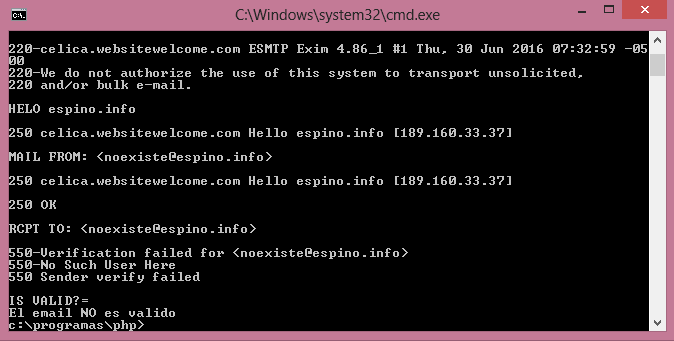Verificar correo electrónico con PHP
Para verificar un correo electrónico, por ejemplo, si realizas una aplicación que necesite el correo del usuario, y todos nos equivocamos, un error de dedo cualquiera lo tiene, y si necesitas validar esta cuentas, es muy útil que verifiques no solamente que tenga el formato correcto, sino que la cuenta exista, antes de enviar el correo para decirle al usuario en ese momento que se equivocó.
En php lo logramos estableciendo una conexión SMTP y verificando que existe la cuenta en el servidor, mediante una serie de comandos.
Para ello, realicé la siguiente clase:
[php]
email = $email;
$this->recordLog = ”;
} // end function __construct
/**
* Regresa TRUE si $string comienza con find
*/
private function stringStartsWith($string, $find) {
return $find === “” || strrpos($string, $find, -strlen($string)) !== FALSE;
} // end function stringStartsWith
/**
* Regresa la parte izquierda de la cadena
*/
static function left($str, $length) {
return substr($str, 0, $length);
} // end function left
/**
* Verifica que el email exista
* Establece una conexión y envia una serie de comandos
* para probar la dirección de correo
*/
function verify() {
try {
// Creamos la conexión
$this->createSMTPConnection();
// Primer HELO, es como iniciar el telnet
$this->sendCommand(“HELO $this->server”);
// Segundo HELO, este si lo cacha el servidor SMTP
$this->sendCommand(“HELO $this->server”);
// Establecemos el FROM
// El FROM no necesariamente tiene que ser un correo válido en el sistema
$this->sendCommand(“MAIL FROM: <$this->email>”);
// Establecemos el destinatario
// Aqui verifica que el correo exista de verdad
$this->sendCommand(“RCPT TO: <$this->email>”);
// Salimos
$this->sendCommand(“QUIT”);
// Cerramos
return $this->close();
} catch ( Exception $ex ) {
$this->isValid = FALSE;
$this->addLog( “error “.$ex->getMessage() );
echo $this->recordLog;
return FALSE;
} // end catch
} // end function verify
/**
* Cierra la conexión, imprime los comandos y las respuestas
* y regresa el resultado
*/
private function close() {
// Cerramos la conexión
$this->closeSMTPConnection();
// Imprimimos el log
echo $this->recordLog;
// Regresamos el resultado
return $this->isValid;
} // end function close
/**
* Agrega una linea de texto al log
*/
private function addLog( $logMessage ) {
$logMessage.=NEW_LINE;
//echo $logMessage;
$this->recordLog.= $logMessage;
} // end function addLog
/**
* Cierra la conexión SMTP
*/
private function closeSMTPConnection() {
fclose( $this->smtpConn );
return;
} // end function closeSMTPConnection
/**
* Envía el comando y procesamos la respuesta
*/
private function sendCommand( $command ) {
// Solo si aun es válido
// si no, ya no realiza los comandos
// Puesto que ya es inválido
if ( !$this->isValid ) {
return true;
}
// Agregamos el comando al log
$command.= NEW_LINE;
$this->addLog( $command );
// Enviamos el comando
fwrite($this->smtpConn, $command);
// Obtenemos la respuesta
$this->getResponse();
// Procesamos la respuesta
$this->parseResponse();
// Regresamos que el comando se envío correctamente
// no el resultado
return true;
}
/**
* Procesa la respuesta
*/
private function parseResponse() {
// Obtenemos el codigo de la respuesta
$response = $this->left( $this->lastResponse, 3 );
// Estas son las válidas
$ok = array( 220, 221, 250);
// Si está en las válidas
if ( in_array( $response, $ok ) ) {
// Es válido
$this->isValid = TRUE;
} else {
// No es válido
$this->isValid = FALSE;
} // end if
} // end function parseResponse
/**
* Obtiene la respuesta
*/
private function getResponse() {
// Aqui almacenaremos la respuesta
$output = ”;
// Mientras haya conexión y mande datos
while ( is_resource( $this->smtpConn ) && !feof( $this->smtpConn ) ) {
// Obtenemos una linea
$line = @fgets( $this->smtpConn, 515);
// La ponemos en el buffer
$output.= $line;
// Si el cuarto caracter es espacio, se termina
if ((isset($line[3]) and $line[3] == ‘ ‘)) {
break;
} // end if $line[3]
} // end while is_resource
// Agregamos la salida al log
$this->addLog( $output );
// Si la respuesta que obtuvimos es la misma
// que la ultima, volvemos a obtener la respuesta
if ( $this->lastResponse ) {
if ( $this->lastResponse == $output ) {
$output = ”;
while ( is_resource( $this->smtpConn ) && !feof( $this->smtpConn ) ) {
$line = @fgets( $this->smtpConn, 515);
$output.= $line;
if ((isset($line[3]) and $line[3] == ‘ ‘)) {
break;
}
}
$this->addLog( $output );
}
}
// Ahora si la ponemos en la última respuesta
$this->lastResponse = $output;
// Regresamos la respuesta
return $output;
} // end function getResponse
/**
* Crea una conexión SMTP
*/
private function createSMTPConnection() {
// Obtenemos las partes del email
$parts = explode(‘@’,$this->email);
// La segunda parte es el dominio
$domain = $parts[1];
// Obtenemos los records mx
$mxhosts = array();
$mxweights = array();
$isMx = getmxrr($domain, $mxhosts, $mxweight);
if ( empty( $mxhosts ) ) {
throw new Exception( ‘No mx records’ );
}
// El dominio, el servidor al que vamos a apuntar
// es el primer registro mx
$domain = $mxhosts[0];
// El puerto es el 25
$port = 25;
// Obtenemos la dirección IP
$address = gethostbyname($domain);
// formamos la dirección con protocolo, ip y puerto
$to = “tcp://$address:$port”;
// Intentamos crear el socket
$this->smtpConn = stream_socket_client($to, $errno, $errorMessage, 10);
// Si no se logro conectar
// hay un error
if ( $this->smtpConn === false ) {
throw new UnexpectedValueException(“Connection failed, error: $errorMessage”);
} // end if
// Establecemos el servidor
$this->server = $domain;
// True por que nos conectamos
return true;
} // end createSMTPConnection
} // end class EmailVerifier
[/php]
La utilizamos de la siquiente manera:
[php]
$verifier = new EmailVerifier( ‘noexiste@espino.info’ );
$verifier->verify();
$isValid = $verifier->isValid;
echo “IS VALID?= $isValid”.NEW_LINE;
if ( !$isValid ) {
echo( “El email NO es valido” );
}
[/php]
Como pueden ver es fácil, rápido y sencillo de utilizar. Espero que les sea útil.
Happy coding! 🙂


admin
June 30, 2016
PHP
No Comment